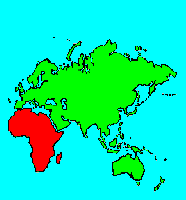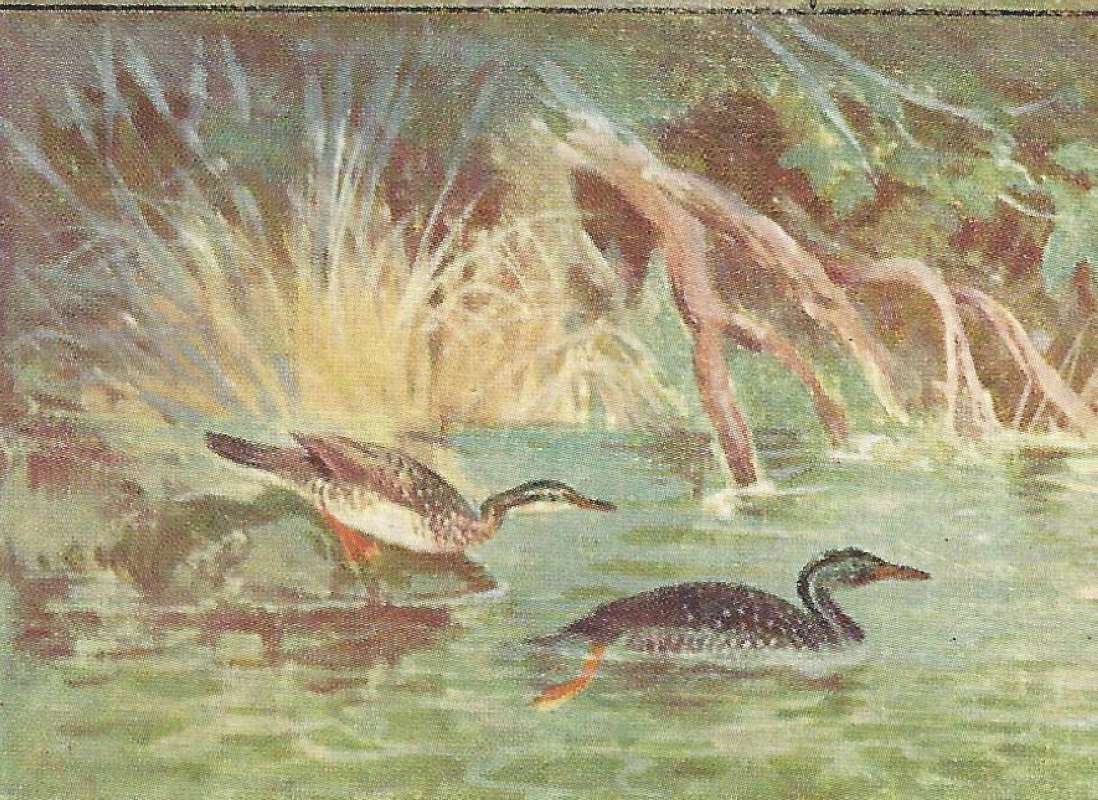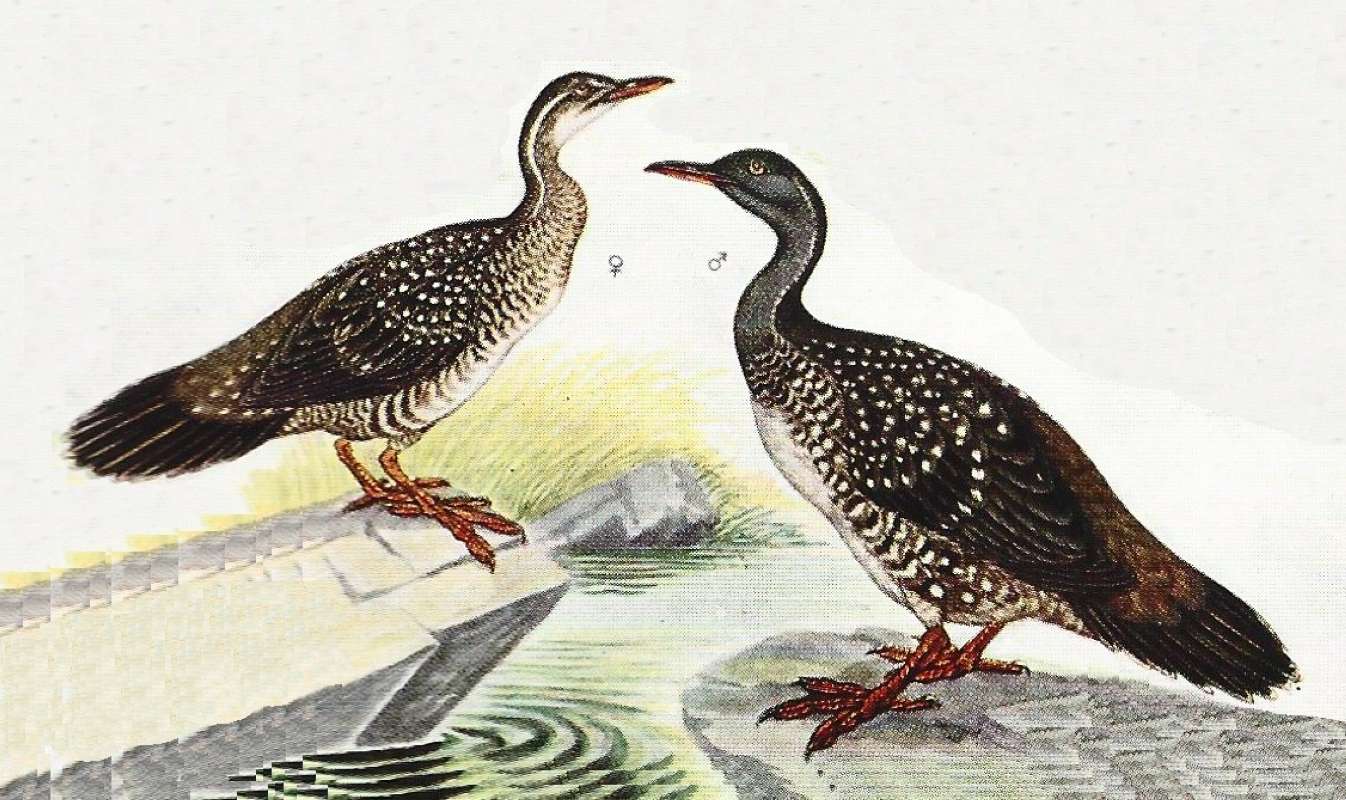SPECIES INFO
African finfoot (Podica senegalensis)is found widely and intermittently in Africa. In the northern areas of Africa this is found from Senegal east to Chad and south to Gabon and the Central African Republic. This is found in south central Africa from southern Zaire and Zambia east to Zimbabwe. There is also another large area of distribution through most of Mozambique south through eastern South Africa to the Cape.
This large 26 inch bird reminds one of both a loon and a duck. Adults have a red bill. The male has a black head and neck, while the female has a brown face and neck fronted by a white throat area. When on the water, the back of both sexes is brown marked with white spots. Sometimes, however, this bird swims low in the water with only the head showing. The brown female and the young can show a white line from the eye that extends down the side of the neck.
There are four subspecies as listed in Howard and Moore in 2003. The nominate subspecies, Podica senegalensis senegalensis, is found from Senegal south to Nigeria and further south to Zaire and Uganda. This is also found from Senegal east to Ethiopia and south to north western Tanzania. The subspecies camerunensis is found from southern Cameroon into Gabon and east into the Congo Basin. The subspecies somereni is found from central Kenya to northern eastern Tanzania. The subspecies petersii is found in southern Africa from Angola east to Mozambique and south to South Africa.Sungrebe or finfoot family (Heliornithidae) is a small family of three species in the Gruiformes. One species is found in Africa, another is found in southern Asia, and the third is found in the New World tropics. These are large swimming birds that remind one of loons. They can float on the water, but perhaps not quite as high as ducks or geese. At times, some species can swim with only their head and neck showing.
Cranes and Rails (Order Gruiformes) are a worldwide group of 199 species, some of which have recently become extinct. They are medium to large in size and usually associated with water. Several species have long legs and/or long necks.
Aves contains about 8,650 different species of living birds known to science. Each year about one new species is discovered in some remote rain forest or remote island. In addition, scientists have been raising many subspecies to full species status which may raise the species count to 10,000. Birdlife recognizes 10,027 species as of 2011.
However, each year about one species goes extinct. The rate of extinction is increasing, and the rate of new discovery is decreasing, so that the number of bird species will soon begin to decline rapidly. Although different taxonomists would organize the birds differently, there are approximately twenty-seven orders of birds. These orders are broken down into about one hundred and fifty-five different families.
Recent research of the genetic structure of some of the shore birds and owls would indicate that the present organization of orders and families should have some modification.
The birds are a worldwide group of animals that are characterized by having the front limbs modified into wings that are used for flying. Perhaps the most unique feature of the birds is the feathers. These feathers are made up of a central support called a quill and a series of small filaments that are hooked together as barbs.
For many years it was believed that Archaeopteryx discovered in Bavaria was the oldest bird from about 150 million years ago. However, in l986, Sankar Chattterjee, a Texas paleontologist, reportedly discovered a bird in the genus Protoavis that lived about 225 million years ago.
When this project was begun in 1978, we used Austin & Singer for bird taxonomy. Since then, we have adopted many changes, but have kept some older concepts that are still found widely in the literature. Recently, we have used Clements and Howard & Moore. Very recently, we have used Monroe and Sibley for the higher taxonomy of the perching birds.
Backboned Animals (Phylum Chordata) are the most advanced group of animals on earth. These animals are characterized by having a spinal cord or backbone. Most members have a clearly defined brain that controls the organism through a spinal cord. Fish, amphibians, reptiles, birds, and mammals are in this phylum.
Currently, some taxonomists believe that the fish should be divided into two groups (sharks and regular fishes) and that there are some other primitive groups in the phylum such as hagfish or lampreys.
Animal Kingdom contains numerous organisms that feed on other animals or plants. Included in the animal kingdom are the lower marine invertebrates such as sponges and corals, the jointed legged animals such as insects and spiders, and the backboned animals such as fish, amphibians, reptiles, birds, and mammals.






